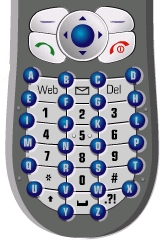Innovation squeezes alphabet keys into normal-sized keypads
Aug 25, 2005 — by LinuxDevices Staff — from the LinuxDevices Archive — views Digit Wireless has created a mobile device keypad approach that adds a full alphabet's worth of buttons to a standard numeric layout. The company claims FasTap, which it is showcasing at the Intel Developer Forum this week, is no larger than a typical mobile phone keypad.
Digit Wireless has created a mobile device keypad approach that adds a full alphabet's worth of buttons to a standard numeric layout. The company claims FasTap, which it is showcasing at the Intel Developer Forum this week, is no larger than a typical mobile phone keypad.
 The FasTap keypad layout has 26 round alphabetical buttons and 18 rectangular numeric and function buttons arranged in a grid-like array, with the alphabetic buttons situated at the corners of the numeric and function buttons.
The FasTap keypad layout has 26 round alphabetical buttons and 18 rectangular numeric and function buttons arranged in a grid-like array, with the alphabetic buttons situated at the corners of the numeric and function buttons.
Users need not be as careful as when using standard, 12-key keypads that require multiple taps to select a number or letter. Instead, with the FasTap approach, the user taps just once to indicate each desired letter or number.
Accidental letter-taps are ignored via a software algorithm that assumes users are much more likely to accidentally hit letters keys — which are raised relative to the number keys — than number keys. By ignoring letter taps that occur essentially simultaneously with number taps, virtually all input errors are eliminated, according to Digit Wireless founder and CTO David Levy.
As a result, FasTap can greatly simplify sending text messages and emails on mobile phones and other handheld devices, the company claims.
According to Levy, Telus Mobility, a major wireless phone carrier in Canada, already has begun supplying a FasTap-enabled LG phone to its customers, with promising results. Levy says that Telus has found that FasTap resulted in a “doubling of data revenue,” and that as a result Telus plans to introduce a second FasTap phone next year. FasTap phones will be introduced into the US mobile phone market next year, Levy adds.
Digital Wireless does not produce hardware or software. Rather, it licenses the FasTap keypad concept to device-makers, and offers assistance with integrating its technology into devices. Last March, the company raised $6 million in Series B funding, which included the participation of two prior investors, Qualcomm and Telus Mobility Ventures.
This article was originally published on LinuxDevices.com and has been donated to the open source community by QuinStreet Inc. Please visit LinuxToday.com for up-to-date news and articles about Linux and open source.